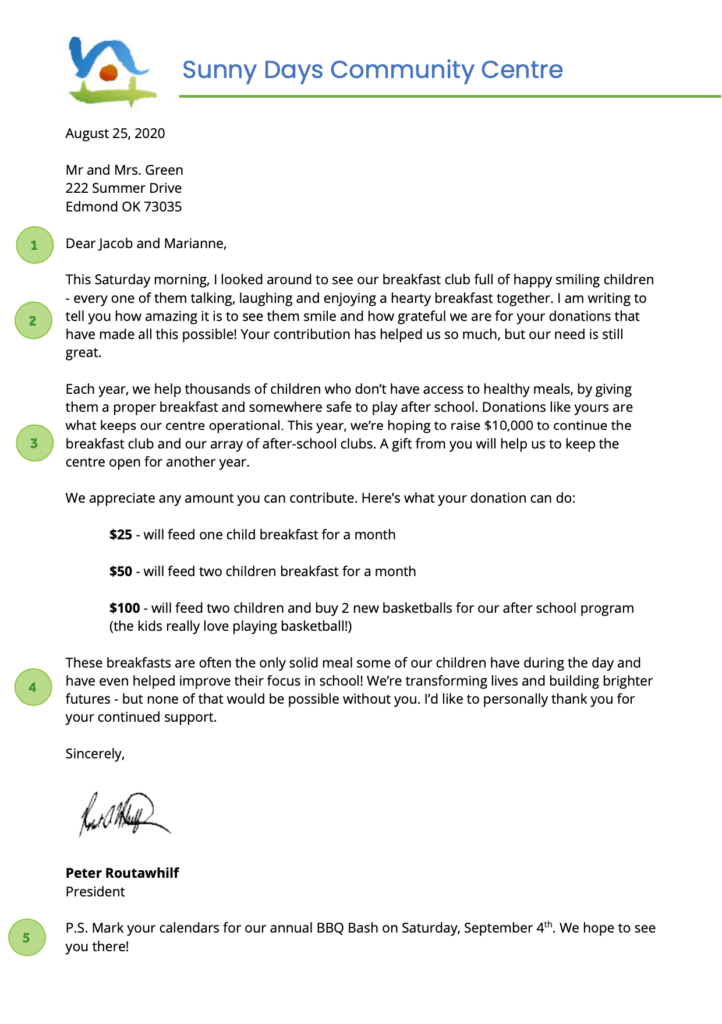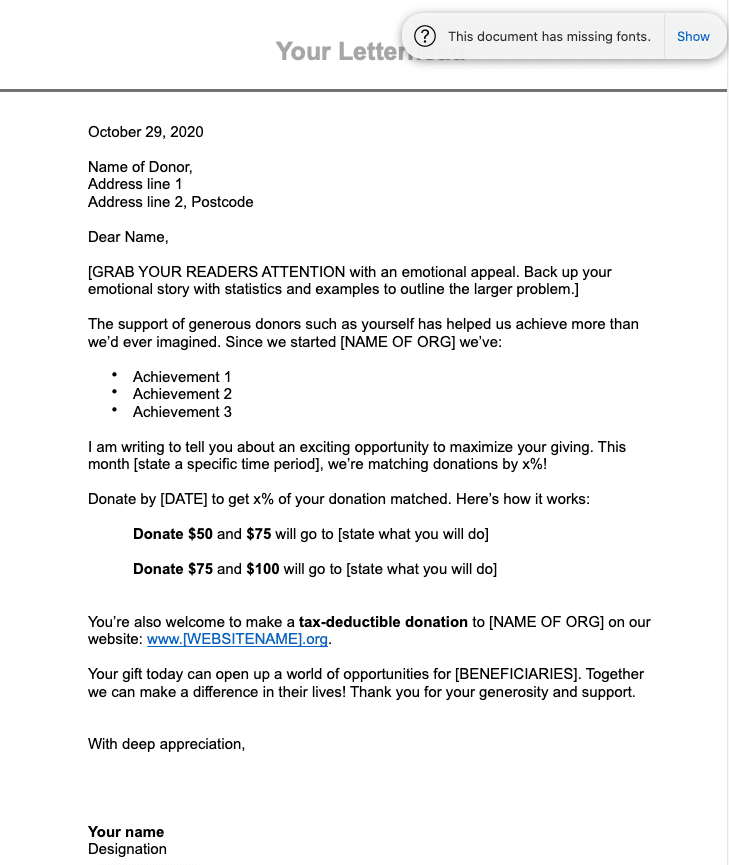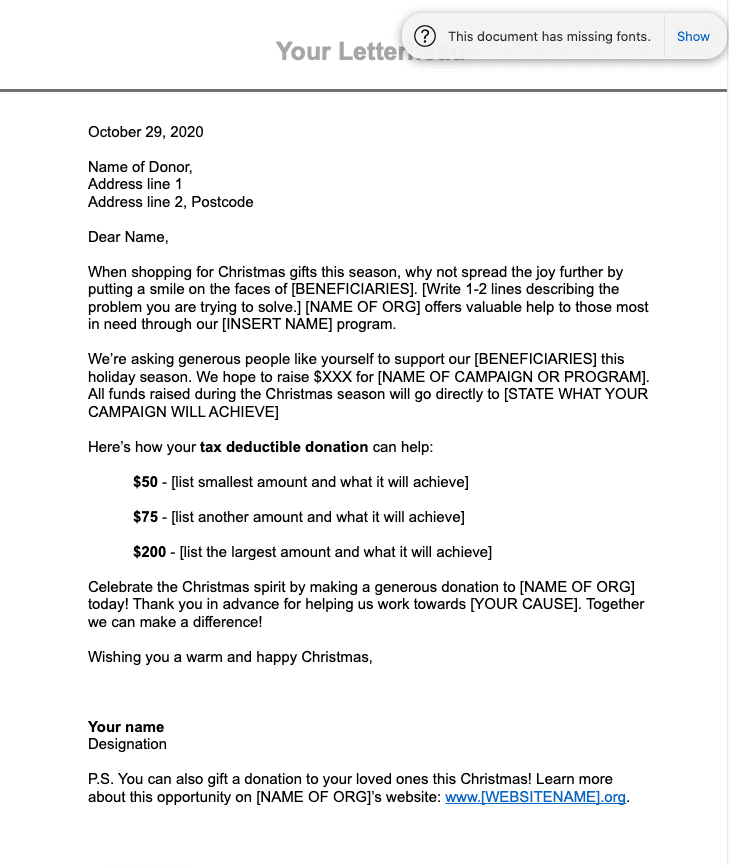
You know you have a good cause worthy of support, but writing a fundraising letter that convinces potential donors of this is not always easy.
A compelling fundraising letter is one of the most valuable tools in your nonprofit’s fundraising toolkit.
In this article you’ll find advice on how to craft the five major parts of a fundraising letter with examples, fundraising letter templates, and tips to help guide you.
In order to understand how to write the perfect fundraising letter, let’s look at this sample fundraising letter from the Sunny Days Community Centre, which is looking to raise money for their breakfast club program.
Click on the image to download the fundraising letter template in word format (P.S. There are more templates below).

Personalize Letters – You never ever want to address your letter: “Dear Friend/Supporter.” Using a person’s name is important. In their eyes, it means the letter was intended for them, not just some supporter, so it makes them pay attention.
You can automatically personalize fundraising letters with donor information like name, address, salutation, and donation history from your nonprofit CRM software .

Using someone’s first name establishes a direct personal connection with them and will encourage them to read further. People are also much more likely to respond to charity fundraising letters when they are addressed directly – adding a name to mailers has boosted response rates by 30% – 140% in some cases!
Grab the reader’s attention – Start your letter with something that will captivate the reader: a bold question, statement or story of a specific person or situation that your charity has helped.
Telling a story and creating a scene is one of the most successful ways to get your message across. It gives the reader a glimpse into your world and reminds them why your mission is so important. Appeal to their hearts by giving your readers specific details about why the problem you are addressing is important and how your program is solving this.
Example: “We were frozen with shock, amazement, and fear all at the same time…
It had been a long and hard journey through Sudan, and at the end of it we were met by the frail, gaunt and starving bodies of children, teenagers, and adults all rushing towards us. Protruding rib cages and depressed stomachs. Legs as frail and thin as match sticks. It was the most shocking sight we had ever seen.
But with this sight came their smiles, their laughter, their cries of joy, and their warm embraces. Tears were shed on all our shoulders as we were hugged and thanked by many different people.
And suddenly, we all realized how much what we were doing meant to all these people!”
Update the reader on what their last donation achieved – Research shows that telling donors what their last donation achieved before asking for another gift is the key to holding onto your donors and moving them up the donor pyramid.
The extra personal touch also shows that your letter is not part of a generic mass campaign, but written only for them.
Focus on a specific program or initiative – Organizations that have multiple project areas may be inclined to include information about everything they do in one letter, but this is a mistake. Talking about everything is likely to overwhelm the reader and make them feel helpless or unable to solve your problems.
Instead, focus on a particular project or theme and provide details and stories to make it real for the reader. This will help readers feel like they can make a difference and do something positive quickly and easily – making them more likely to respond with a cheque!
Thank donors and tell them they are necessary – If you are writing to previous donors, be sure to thank them for their previous contributions and tell them that they are still needed; that you require their help to keep your services going.
Making donors feel valued and appreciated will build their commitment to your cause and can help convert one-time donors into regular contributors.
Explain the cause – You want to leave people with the impression that it is absolutely critical that you continue to do what you do. In order to do that, you need to show that there is a need and that your organization is critical in effectively addressing that need.
Present your goal – Tell donors exactly what you need within a specific time frame to help them understand how their donations will be used and who will benefit. Without a clear goal donors won’t know where their money is going or how they can make a difference. Having a goal can give them a sense of purpose and might even prompt them to ask friends to contribute if they notice you’re really close to achieving your campaign goal.
Suggest donation amounts and what it will achieve – You should also list suggested donation amounts that are appropriate for the particular donor. Be sure to state the impact of the gift so donors know exactly what they are giving.
Example: “Your donation of $25 will feed and clothe a hungry child for a month.”
Detail the consequences of not acting – In order to show the donor that their donation is important, you may also want to state the impact of not acting. You have to be very careful, however, not to sound like you are overly negative. If the message focuses too much on such impacts, it will be a downer and will be much less effective.
Example: “Every donation is important and the need is always great. Without donations like yours, more children will have to go without; without shelter, food and clean water.”
Thank donors in advance for their support – Make sure to thank donors in advance. It subtly assumes that they will contribute to the cause and shows that you have faith in them to do the right thing.
Tell them again why their contribution is so important – You may also want to reinforce here why you need their help and the consequences of not acting.
Include an upcoming event or reinforce your ask – Did you know that postscripts are the most read part of your letter?
Unlike emails, donors will often look at the beginning of the letter and go right to the postscript. Make sure you don’t miss out on this opportunity to grab some attention by adding this section to your fundraising letter.
You can repeat your ask for donations or include information about a fun event or upcoming fundraiser that donors can attend.
If you’re worried about how to get started on writing your fundraising letter, we’ve got you covered! Here are four of the best fundraising letter templates for nonprofits.
Download these fundraising letter templates in Word format to use as a basis for your own fundraising letter.
(Click image to download in Word format)

(Click image to download in Word format)

(Click image to download in Word format)

(Click image to download in Word format)

For more fundraising letter templates, check out our free fundraising letter templates for every sector , including social services, education, arts organizations, animal shelters and more.